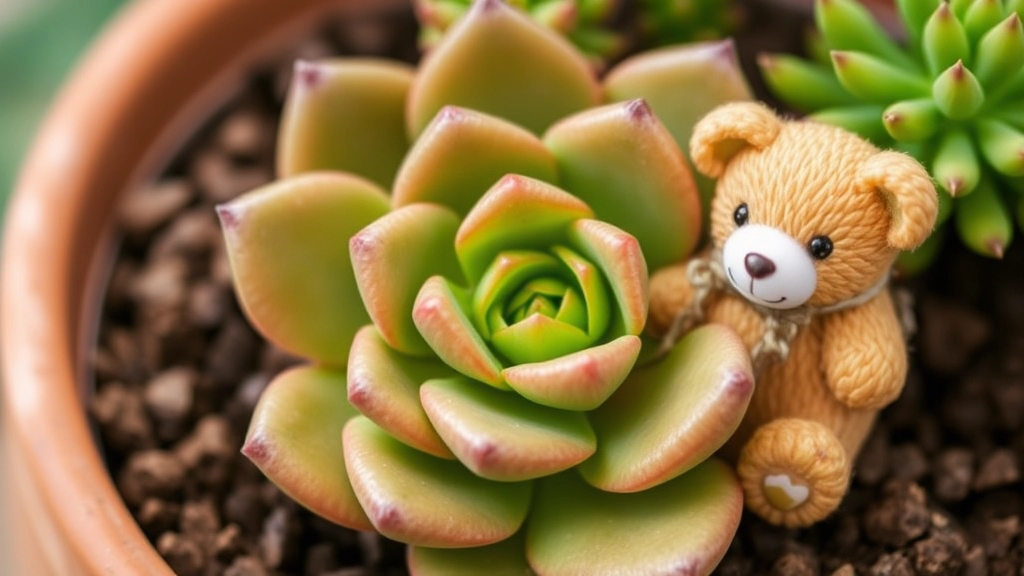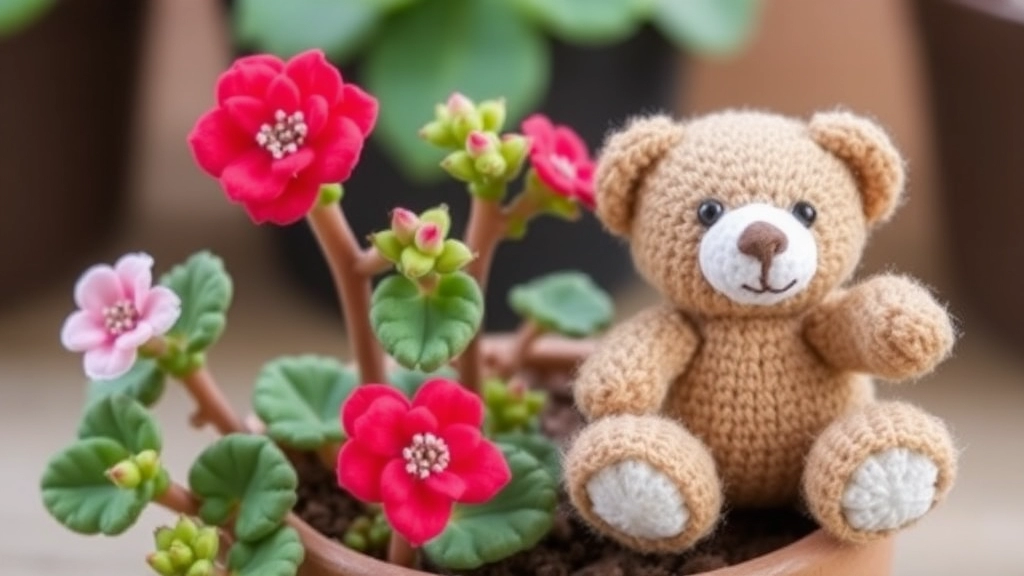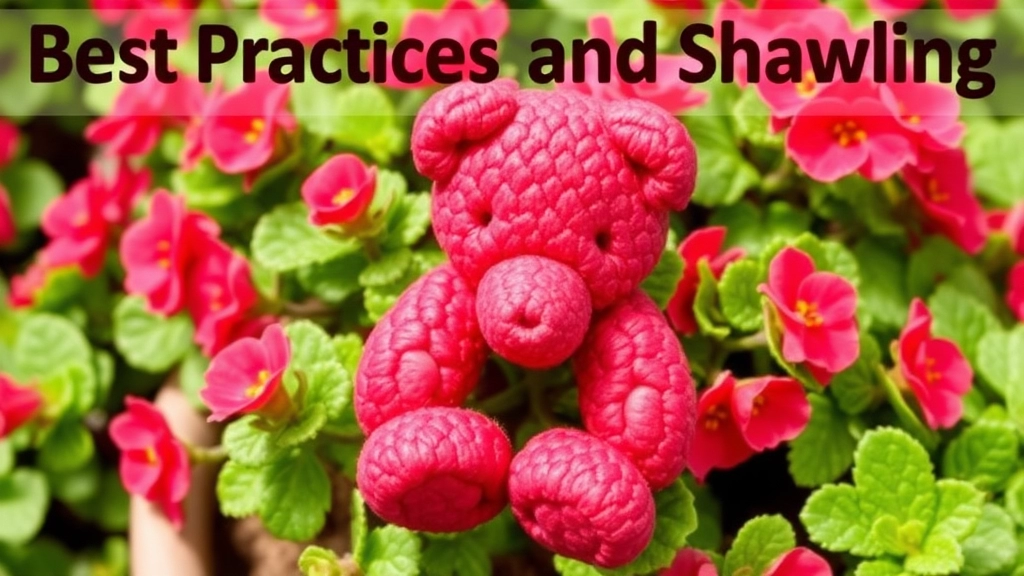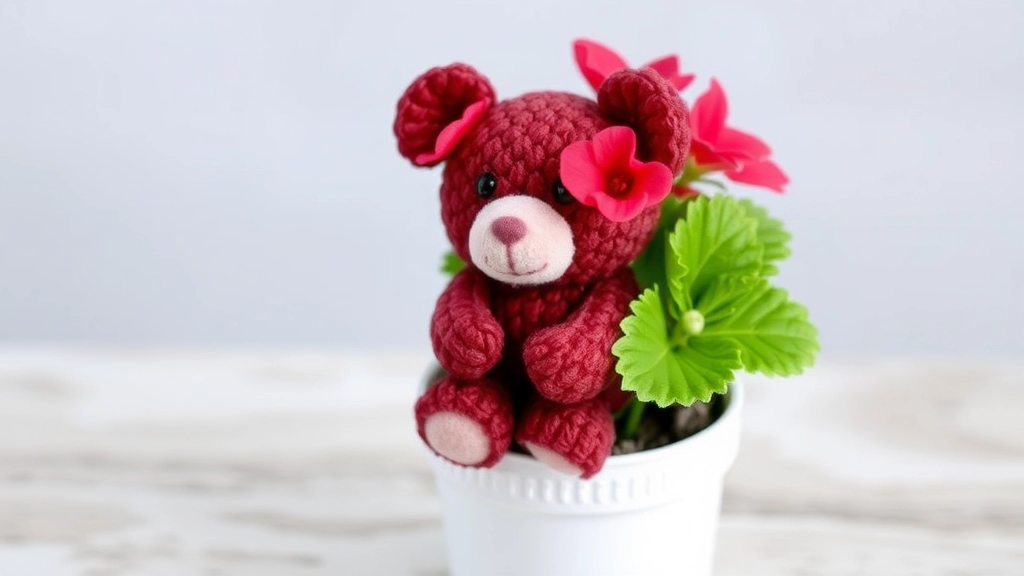Mastering Kalanchoe Teddy Bear Care
Looking to master Kalanchoe Teddy Bear care? You’re in the right place. This adorable succulent, known for its fuzzy leaves, thrives with the right light, water, and soil. Let’s dive into the essentials to keep your Teddy Bear succulent happy and healthy.
Light Requirements
First, ensure your Kalanchoe Teddy Bear gets plenty of bright, indirect light. Direct sunlight can scorch its leaves, so a sunny window with filtered light works best.
Watering Tips
Watering is simple: let the soil dry out completely between waterings to avoid root rot. A well-draining soil mix is crucial for preventing excess moisture.
Conclusion
Follow these tips, and your Kalanchoe Teddy Bear will flourish.
Optimal Light Conditions for Kalanchoe Teddy Bear
When caring for your Kalanchoe Teddy Bear succulent, one of the most pressing concerns is ensuring it receives the right amount of light.
Why is Light Important?
Too little light can lead to leggy growth, while too much can scorch its delicate leaves.
Watering Guidelines for Teddy Bear Succulent

So, you’ve got your Kalanchoe Teddy Bear succulent, and now you’re wondering how much water it really needs? You’re not alone! Many plant lovers stress over watering, and it can be a bit tricky.
Understanding Watering Needs
Kalanchoe Teddy Bear is a succulent, which means it stores water in its leaves. That’s great because it doesn’t need a lot of water compared to other houseplants. Here’s how to nail it:
- Let it Dry Out: Always let the soil dry out completely between waterings. Stick your finger about an inch into the soil; if it feels dry, it’s time to water.
- Watering Schedule: During the growing season (spring and summer), you might water every 2-3 weeks. In the winter, cut back to once a month or even less.
- Watering Technique: When you water, do it thoroughly. Pour water until it drains out of the bottom of the pot. This encourages deep root growth.
- Signs of Overwatering: Yellowing leaves or mushy stems? You might be overdoing it. Cut back on water and let the plant breathe.
- Signs of Underwatering: If the leaves start to wrinkle or look shriveled, it’s time to give it a drink.
Choosing the Right Soil for Healthy Growth
When it comes to nurturing your Kalanchoe Teddy Bear, the right soil is essential for ensuring optimal growth. Many plant enthusiasts often wonder, “What type of soil is best for my succulent?”
Temperature and Humidity Requirements

When caring for your Kalanchoe Teddy Bear succulent, understanding its temperature and humidity needs is crucial for optimal growth.
Ideal Temperature Range
Kalanchoe Teddy Bear thrives in a warm environment. Here’s what you should keep in mind:
- Daytime Temperature: Ideally between 20°C to 24°C (68°F to 75°F).
- Nighttime Temperature: A drop to around 10°C to 15°C (50°F to 59°F) is acceptable.
- Avoid Extreme Heat: Temperatures above 30°C (86°F) can stress the plant.
Humidity Levels
These succulents prefer dry conditions. Here’s how to manage humidity:
- Low Humidity: Aim for humidity levels below 50%.
- Avoid High Humidity: Prolonged exposure to high humidity can lead to rot and disease.
Tips for Maintaining Conditions
- Location: Place your Kalanchoe Teddy Bear in a spot that avoids drafts and sudden temperature changes.
- Indoor Heating/Cooling: Be mindful of air conditioning and heating systems that may create fluctuating temperatures.
- Humidity Control: If you live in a humid area, consider using a dehumidifier or placing the plant in a well-ventilated room.
Repotting Your Kalanchoe Teddy Bear Succulent
Are you wondering when and how to repot your Kalanchoe Teddy Bear succulent? This is a common concern for many plant enthusiasts. Repotting is essential for maintaining the health and growth of your succulent.
When to Repot
- Signs of Overcrowding: If you notice roots growing out of the drainage holes or the plant appears top-heavy, it’s time to repot.
- Soil Degradation: If the soil looks compacted or depleted of nutrients, a fresh mix is necessary.
- Growth Stagnation: If your succulent’s growth seems to have slowed down, it may need more space.
Choosing the Right Pot
- Size: Select a pot that is one size larger than the current one. Too much space can lead to overwatering issues.
- Material: Terracotta pots are ideal as they allow for better airflow and moisture control.
Steps to Repot
- Prepare Your Materials: Gather a new pot, fresh succulent soil, and a small trowel.
- Remove the Plant: Gently take the Kalanchoe out of its current pot, being careful not to damage the roots.
- Inspect the Roots: Trim any dead or damaged roots with sterilised scissors. This promotes healthy growth.
- Add Soil: Place a layer of fresh soil at the bottom of the new pot.
- Position the Plant: Set your Kalanchoe Teddy Bear in the pot and fill around it with more soil, ensuring it sits at the same depth as before.
- Water Sparingly: After repotting, wait a week before watering to allow the roots to heal.
By following these steps, you can ensure your Kalanchoe Teddy Bear has the space and nutrients it needs to thrive. For more detailed care instructions, you might find this care guide for Kalanchoe Tomentosa useful. Additionally, if you are interested in propagation, check out this step-by-step guide to Kalanchoe propagation.
How to Propagate Kalanchoe Teddy Bear: Step-by-Step Guide

So, you’ve got your Kalanchoe Teddy Bear thriving, and now you’re wondering how to get more of these adorable succulents. Propagation is a fantastic way to expand your collection or share with friends. Let’s dive into this simple process!
Why Propagate?
Propagation is not just about getting more plants; it’s also a way to ensure you’re nurturing the health of your existing plant. Plus, there’s something super satisfying about watching new growth emerge.
Step-by-Step Propagation Guide
- Choose the Right Time
- Spring or early summer is ideal for propagation. The warmer weather encourages quicker growth.
- Select a Healthy Leaf or Stem
- Look for plump, healthy leaves or stems. Avoid any that look wilted or discolored.
- Cut the Leaf or Stem
- Use clean, sharp scissors to take a cutting. Aim for a stem about 3-4 inches long or a healthy leaf.
- Let It Callus
- Place your cutting in a dry spot for a few days. This allows the cut end to callus over, which helps prevent rot.
- Prepare Your Soil
- Use a well-draining succulent mix. You can even mix regular potting soil with sand or perlite for better drainage.
- Plant the Cutting
- Once the cutting has callused, plant it in the soil, burying the cut end about an inch deep.
- Water Sparingly
- Give it a light misting of water. Avoid soaking it; too much moisture can lead to rot.
- Provide Proper Light
- Place your pot in bright, indirect sunlight. Direct sunlight can scorch the new cutting.
- Be Patient
- Roots will start to develop in a few weeks. You’ll know it’s ready when you see new growth.
Tips for Success
- Avoid Overwatering: This is a common mistake. Less is more when it comes to watering.
- Use Sterilized Tools: This helps prevent disease transmission.
- Keep an Eye on Humidity: Too much humidity can hinder the rooting process.
Propagation can be a rewarding experience, and soon enough, you’ll have a small army of Kalanchoe Teddy Bears to enjoy!
Managing Common Pests and Diseases
As you nurture your Kalanchoe Teddy Bear succulent, you may encounter some common pests and diseases that could hinder its growth. Understanding how to manage these issues is essential for keeping your plant healthy and thriving.
Common Pests
- Mealybugs
Look for white, cotton-like clusters on the leaves.
Treat with a cotton swab dipped in rubbing alcohol. - Aphids
Tiny, green insects that can be found on new growth.
Spray with a mixture of water and dish soap to dislodge them. - Spider Mites
Fine webbing on the underside of leaves indicates their presence.
Increase humidity and use insecticidal soap for control.
Common Diseases
- Root Rot
Caused by overwatering; look for mushy roots.
Ensure proper drainage and allow the soil to dry out between waterings. For more detailed information, you can refer to the Complete Care Guide for Kalanchoe Flaming Katy. - Powdery Mildew
White, powdery spots on leaves can indicate this fungal disease.
Improve air circulation and remove affected leaves. Learn more prevention tips from the Care Tips for Kalanchoe Succulent with Yellow Flowers.
Prevention Tips
- Inspect Regularly: Check your plant weekly for any signs of pests or diseases.
- Maintain Proper Watering: Avoid overwatering to prevent root rot.
- Use Clean Tools: Sanitize your gardening tools to reduce the risk of spreading diseases.
Best Practices for Pruning and Shaping Kalanchoe Teddy Bear

So, you’ve got your Kalanchoe Teddy Bear thriving, and now you’re wondering how to keep it looking its best. Pruning and shaping your succulent isn’t just about aesthetics; it promotes healthy growth and prevents overcrowding.
Why Prune?
- Encourages Growth: Snipping away dead or wilting leaves helps the plant focus its energy on new growth.
- Shaping: You can create a fuller, bushier plant by trimming back leggy stems.
- Health: Removing diseased or pest-infested parts keeps your succulent strong.
When to Prune
- Springtime: This is the best time for pruning; your plant is waking up and ready to grow.
- After Flowering: If your Teddy Bear has bloomed, a trim can help redirect energy back to the leaves.
How to Prune
- Gather Your Tools: A clean, sharp pair of scissors or pruning shears.
- Inspect Your Plant: Look for dead leaves, leggy growth, or any signs of disease.
- Make Your Cuts:
- Trim dead or yellowing leaves at the base.
- Cut back any long stems to promote bushiness.
- Aim for a clean cut to avoid damaging the plant.
- Clean Up: Remove any fallen leaves from the soil to prevent mould.
Shaping Tips
- Go for Symmetry: Try to maintain an even shape as you prune.
- Encourage Branching: Cut just above a leaf node to encourage new branches.
- Don’t Overdo It: Less is more; you can always trim more later.
Creative Display and Design Ideas for Kalanchoe Teddy Bear Succulent
Are you wondering how to showcase your Kalanchoe Teddy Bear succulent in a way that truly highlights its unique charm?
This delightful plant deserves a spot that not only enhances its beauty but also complements your living space. Here are some creative display ideas to inspire you:
1. Stylish Pots and Planters
- Textured Ceramic Pots: Opt for pots with unique textures or patterns to add depth.
- Hanging Planters: Elevate your succulent by using hanging planters, creating a stunning visual effect.
- Terracotta Pots: These classic choices offer excellent drainage and a rustic look.
2. Group Planting
- Mixed Succulent Arrangements: Combine your Kalanchoe Teddy Bear with other succulents for a vibrant display.
- Themed Displays: Create a desert-themed arrangement with sand and stones for a natural feel.
3. Shelving and Stands
- Tiered Plant Stands: Use tiered stands to showcase multiple plants at different heights, allowing each to shine.
- Wall-Mounted Shelves: Install shelves on your wall to create a vertical garden effect.
4. Natural Elements
- Wooden Crates: Place your succulent in a rustic wooden crate for a charming farmhouse vibe.
- Stone or Pebble Bases: Surround your plant with stones or pebbles to mimic its natural habitat.
5. Seasonal Decor
- Festive Themes: Change the display according to seasons or holidays, using decorative elements that complement your Kalanchoe.
- Color Coordination: Match the pot or decor with the colour scheme of your room for a cohesive look.
6. Lighting Effects
- Spotlights: Use small spotlights to draw attention to your succulent, especially in dimly lit rooms.
- Fairy Lights: Wrap fairy lights around the pot for a whimsical touch.
By implementing these creative display ideas, you can transform your Kalanchoe Teddy Bear into a stunning focal point in your home. For more tips on caring for your succulent, check out our ultimate care guide for Kalanchoe Tomentosa. Additionally, if you’re interested in propagating your plant, our step-by-step guide on Kalanchoe leaf propagation can provide you with all the necessary information.
Frequently Asked Questions about Kalanchoe Teddy Bear Care
How often should I water my Kalanchoe Teddy Bear succulent?
Water your Kalanchoe Teddy Bear succulent every 2-3 weeks during the growing season (spring and summer). In the winter, reduce watering to once a month or even less. Always let the soil dry out completely between waterings.
What are the signs of overwatering and underwatering?
Overwatering can cause yellowing leaves and mushy stems. Underwatering typically results in wrinkled or shriveled leaves. Adjust your watering schedule accordingly if you notice these signs.
What temperature range is ideal for Kalanchoe Teddy Bear?
The ideal daytime temperature for Kalanchoe Teddy Bear is between 20°C to 24°C (68°F to 75°F), while the nighttime temperature can drop to around 10°C to 15°C (50°F to 59°F). Avoid exposing the plant to temperatures above 30°C (86°F).
What humidity levels are best for Kalanchoe Teddy Bear?
Kalanchoe Teddy Bear prefers low humidity levels, ideally below 50%. High humidity can lead to rot and disease, so it’s important to maintain dry conditions.
How do I propagate my Kalanchoe Teddy Bear?
To propagate your Kalanchoe Teddy Bear, follow these steps:
- Choose a healthy leaf or stem in spring or early summer.
- Use clean, sharp scissors to take a cutting.
- Let the cutting callus over for a few days.
- Plant the cutting in well-draining soil.
- Water sparingly and place in bright, indirect sunlight.
Be patient; roots will develop in a few weeks, and you’ll see new growth.
When is the best time to prune my Kalanchoe Teddy Bear?
Springtime is the best time for pruning as the plant is waking up and ready to grow. You can also prune after flowering to help redirect energy back to the leaves.
How should I prune my Kalanchoe Teddy Bear?
To prune your Kalanchoe Teddy Bear:
- Gather clean, sharp scissors or pruning shears.
- Inspect your plant for dead leaves, leggy growth, or signs of disease.
- Trim dead or yellowing leaves at the base and cut back long stems to promote bushiness.
- Remove any fallen leaves from the soil to prevent mold.
What are some tips for shaping my Kalanchoe Teddy Bear?
When shaping your Kalanchoe Teddy Bear:
- Maintain an even shape for symmetry.
- Encourage branching by cutting just above a leaf node.
- Don’t overdo it; you can always trim more later.
Why should I propagate my Kalanchoe Teddy Bear?
Propagation allows you to expand your collection and ensure the health of your existing plant. Plus, it’s satisfying to watch new growth emerge!
What tools do I need for pruning?
A clean, sharp pair of scissors or pruning shears are essential for pruning your Kalanchoe Teddy Bear.
References
-
How to Grow Kalanchoe Plants
-
Kalanchoe Care: Growing Kalanchoe as a Houseplant
-
How to Care for a Kalanchoe
